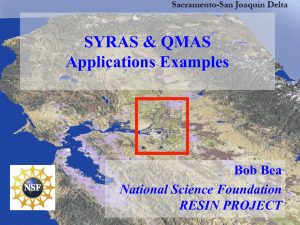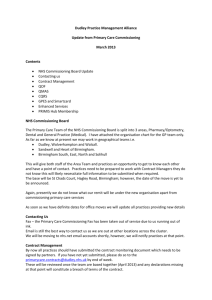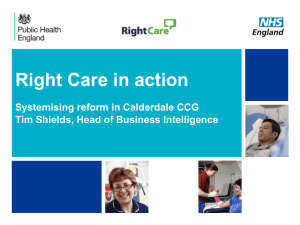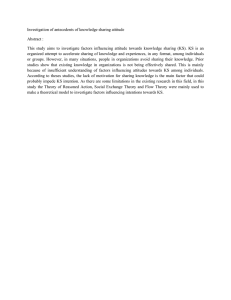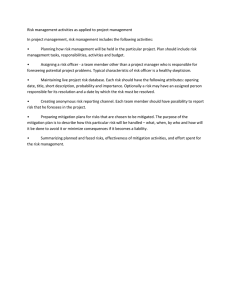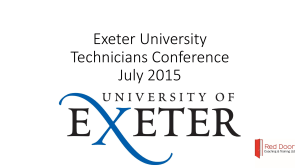Advanced Engineering Risk Audit Instruments SYRAS & QMAS Bob Bea
advertisement
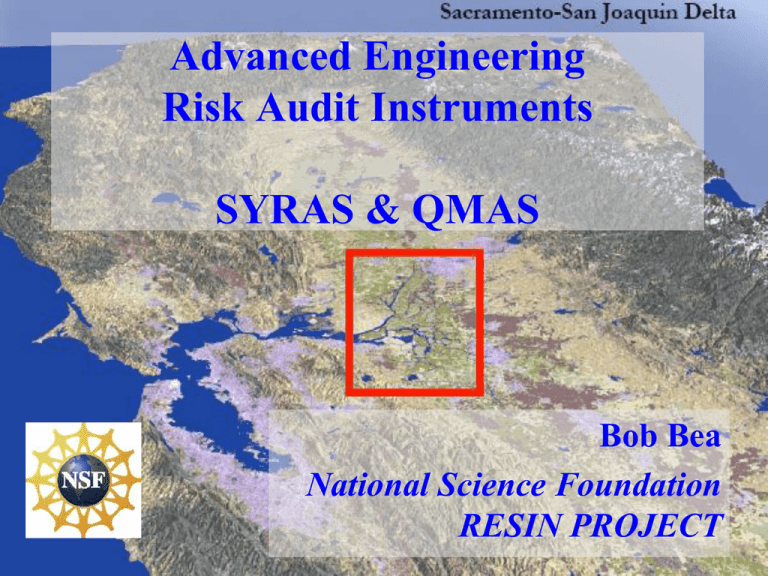
Advanced Engineering Risk Audit Instruments SYRAS & QMAS Bob Bea National Science Foundation 1 RESIN PROJECT Define & Characterize System, Performance Attributes & Failures Operators, Organizations, Environments Hardware, Structures, Procedures, Interfaces QMAS Audit team, Audit training, Audit scheduling Screening assessments, Factors of Concern Gradings, Consequences of 'Failure', Remediations SYRAS Normal rates of malfunctions, Performance Shaping Factors Probabilities of proper Detection, Analysis, Correction Probabilities of Failure for all System Components, Correlations Probabilities & Consequences of Failure As Is Mitigation Measures Probabilities & Consequences of Failure As Could Be Implementation Programs 2 Managing Pfi Pfi Concept Definition Design Construction Maintenance Decommissioning Reduce Likelihoods Present Future Reduce Effects Increase Detection & Correction Increase Margins of Quality 3 Managing Cfi Cfi Rescue Repair Recovery Rehabilitation Direct Immediate Delayed Indirect On-Site Off-Site 4 Resilience - time & cost to regain Functionality Good resililence 100 % Functionality Poor resililence rehabilitation rescue recovery repair Time 5 Benefits / Costs Sustainability - Utility during life cycle High Sustainability Improvement Utility Initiation Operation Low Sustainability Decay Time 6 PROACTIVE to prepare increase detection & correction reduce likelihoods reduce consequences REACTIVE to recover INTERACTIVE to respond 7 Analytical methods QUALITATIVE 'soft' - linguistic v ariables 'subj ectiv e' integration Moderate Low High QUANTITATIVE 'hard' - numerical v ariables analytical integration 0. 00 5. 00 10.00 MIXED QUALITATIVE & QUANTITATIVE linguistic v ariables translated to numerical v ariables analytical integration Low 0 High Moderate 2. 5 5. 0 7. 5 10 8 System analysis approach Step #1: PERFORM A SYSTEM ANALYSIS defi ne system hardware, software, environments, organi zati ons and i ndivi dual s Step #2: PERFORM A PROCESS ANALYSIS defi ne how thi ngs are done: how the system hardware, software, envi ronments, organi zati ons, and indi viduals work Step #3: PERFORM ANALYSES OF THE SYSTEM & PROCESS AS PRESENTLY CONFIGURED defi ne the l ikel ihood and "quali ty" achieved Step #4: PERFORM ANALYSES OF THE RECONFIGURED SYSTEM & PROCESS defi ne the l ikel ihood and additi onal "qual ity" that could be achi eved 9 Screening analysis strategy Develop Coarse Qualitative Model of Existing "System" Evaluate High Risk Components Identify High Likelihood System Problem and Consequence Components and Potential Mitigation Measures Revise Models and Evaluate Risk Reductions of Mitigation Measures Develop Detailed Quantitative Models of High Risk Components Evaluate Costs and Benefits of Mitigation Measures and Impliment "Most Effective" 10 Objectives of analyses • • • • • • NOT prediction NOT numbers or analytical elegance Detect potential hazards and flaws Evaluate effects of mitigations Disciplined framework for thinking Empower those who have daily responsibilities for quality and reliability 11 12 Example QRA/PRA 13 Proactive - Robustness = damage tolerance defect in tolerant defect tolerant Intensity of damage or defects 14 Quality Attributes SYRAS© Durability Safety QA / QC Design Phase QA / QC Construction Phase Compatibility Serviceability Lifecycle Task Organization Operations Phase Task Organization QA / QC Maintanence Phase Task Organization Task 1 Task 2 Task 3 Task 1 Task 2 Task 3 Base Rates Base Rates Base Rates Base Rates Base Rates Base Rates Influencing Factors Influencing Factors Influencing Factors Influencing Factors Influencing Factors Influencing Factors 15 Independent & Dependent Errors Detection Analysis Failures of QA/QC •lack of expertise •resource deficiencies •excessive authority gradients •communication malfunctions •management breakdowns •rejection of information •violations Errors Correction 16 P[F] = P[FI|E] P[E]+P[FI|E]P[E]+P[FE|E]P[E] due to intrinsic causes with no error due to intrinsic causes with error due to extrinsic causes with error 17 18 19 20 21 22 SMAS Grade 1 Minor negative influence Moderate negative influence Extreme negative influence 1 1E1 1E2 1E3 4 5 6 7 Below average Poor Very poor does not meet any standards or requirement s Moderate positive influence Extreme positive influence Negligible influence 3 1E- 1 Good, average exceeds all standards and requirements 1E- 2 Minor posit ive influence 2 Very good 1E- 3 Excellent Outstanding exceeds all standards and requirements SYRAS PSF 23 QMAS© • • • • Assessment instrument Assessment protocol Assessment team development Follow-up 24 SMAS Main Menu This is the starting point of the SMAS Data Management Tool. Pre-Assessment Data - This way to Pre-Assessment Data Input Menu Phase 1 Data - This way to Phase 1 analysis Data Input Menu Phase 2 Data - This way to Phase 2 analysis Data Input Menu FOCÕs / Scenarios - This way to Factors of Concern / ScenarioÕs Menu Reports - This way to Reports Utilities - This way to Import, Export, Delete Utilities System Exit - This way to Exit SMAS and close MS Access. 25 QMAS components Operating Teams Factors Structural Factors Organizational Factors Interfaces Factors Environmental Factors Hardware Factors Procedural Factors 26 QMAS components, factors, attributes 27 QMAS factors Operating Teams Process Aud iti ng Safety Culture Ris k Perception Emergen cy Preparednes s Command & Controls Training Communications Requisit e Variety Equip ment Design gu idelines and specification s Materials Demand systems Power systems Configurations Control systems Operators & other Organ izations & other Orga nizational Process Aud iti ng Safety Culture Ris k Perception Emergen cy Preparednes s Command & Controls Training Communications Resources Structure Design gu idelines & specs. Materials Loadings Structure configura tion Computer programs Research, development and testing background Interfaces Procedur es & other Envi ronmental & other Proce dures Operating Maintenance QA/QC Contractor selection Pre-start up review Emergen cy response Manage ment of change Validations Environmental Externa l ( Weather) Internal Social External (Regu latory, Society)_ Social (Internal) (Within organ ization and operating team) Equip me nt & other Structure & other 28 29 QMAS gradings 30 Components QMAS mean results Interfaces Environments Highest mitigation priorities Structure Equipment Procedures Organizations Operators 0 1 2 3 4 Grades 5 6 7 31 QMAS protocol Stage #1 ONSHORE general information system specific interviews - operating, management Stage #2 OFFSHORE walk downs operations observations maintenance observations emergency drills interviews anonymous discussions Stage #3 ONSHORE additional information additional interviews 32 QMAS - coarse qualitative 33 QMAS detailed qualitative 34 35 36 QMAS assessors • QMAS counselor • QMAS assessors – Facility operators – Facility management • QMAS training program – HOF background – QMAS operations – QMAS applications 37 QMAS assessors: THE MOST IMPORTANT PART! • Experienced – Facility – Process auditing • • • • • Respected Integrity Motivated Observant Thoughtful, insightful 38 QMAS applications 39
